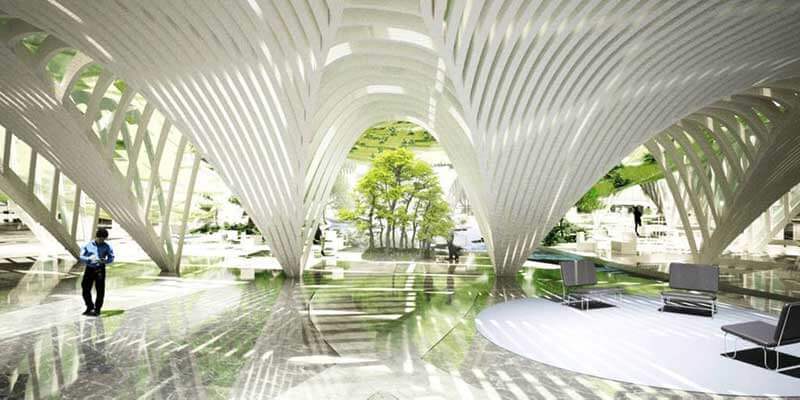- French Dream Towers is a new mixed-use development with an algae-covered exterior and blockchain-monitored building systems
- The algae help with temperature regulation and clean the surrounding air
- The BIQ House is the world’s first algae-powered building
As the effects of climate change become more and more pronounced each day, it’s become abundantly clear that we need to do something to reduce our impact on the environment before it’s too late. The construction industry is one of the world’s biggest polluters – it’s responsible for 39 per cent of global carbon dioxide emissions – which makes it one of the prime candidates for a major makeover. With this in mind, construction companies have increasingly been looking for more sustainable materials and methods in recent years. One of the more intriguing examples involves an organic material that’s commonly found in nature – algae.
Algae are recognised as one of the fastest growing organic materials in the world and could help us reduce the construction industry’s carbon footprint. They have numerous benefits, but the two most important ones are that they’re capable of improving air quality by absorbing carbon dioxide and that they can be used to produce biofuel, which can then be used to power buildings.
French Dream Towers is a new mixed-use development with an algae-covered exterior and blockchain-monitored building systems
The French architectural studio XTU Architects recently unveiled the design for a new state-of-the-art mixed-use development called French Dream Towers. Designed in a collaboration between XTU Architects, the French business consortium Systematic, and an unnamed Chinese developer, the high-end complex will be located on the banks of the West Lake in the Chinese city of Hangzhou. It will feature an algae-covered exterior and blockchain-monitored building systems.

The development consists of four interconnected towers, the French Tech Hug, the Art Center, the Hospitality Tower, and the Haute Gastronomie. The French Tech Hub will house offices, coworking spaces, a startup accelerator, and a digital cluster. The Art Center will include art galleries, an art market, and artists’ residences. The Hospitality tower will feature a hotel, a spa, healthcare facilities, and beauty shops, and the Haute Gastronomie will be home to French cuisine and fusion restaurants, as well as a panoramic bar. The ground floor below will serve as a public space for the towers’ occupants and visitors.
The design of the towers was inspired by a variety of sources, ranging from Chinese history and nature to haute-couture fashion, and it features curved, twisting shapes that bring to mind many different images, depending on the viewing angle. “The large roof evokes the traditional architecture of pagodas, but the shaping of the façade also recalls an embellishment of fabrics and different materials, highlighting the diagonal movements of the design… a torsion which suggests the motion of a long twirling dress”, explains Anouk Legendre, a co-founder of XTU Architects.
The algae help with temperature regulation and clean the surrounding air
The most interesting aspect of the towers’ design is the microalgae-clad façade, which helps regulate the temperature within the buildings. “The cultivation of micro-algae on the building façade is a process that has been in development at XTU for many years”, says Legendre. “It allows for a symbiosis: the bio-façade uses thermal materials to regulate the growing temperature of algae, which in turn contributes to the thermal regulation of the building”.
The towers will also incorporate other green features, including a rainwater harvesting system, an aquaponics system, and a greenhouse. The flora will help the towers clean the surrounding air, absorbing carbon dioxide and producing oxygen. The buildings’ air quality, energy storage, and various environmental systems will be monitored by a blockchain-based IoT network, which was developed by a local company called Gold Truffle Engineering.
The BIQ House is the world’s first algae-powered building
This isn’t the first time algae were incorporated into the design of a building. In 2013, the London-based engineering firm Arup unveiled the world’s first algae-powered building, called the BIQ (Bio-Intelligent Quotient) House. Designed in cooperation with the German consultancy SSC Strategic Science Consult and the Austrian firm Splitterwek Architects, the five-storey BIQ building is located in Hamburg, Germany, and features an innovative outer shell that consists of live microalgae encased in glass louvres, which allows the building to produce its own energy and provide shading to its occupants.
“To use bio-chemical processes for adaptive shading is a really innovative and sustainable solution, so it is great to see it being tested in a real-life scenario”, says Jan Wurm, a research leader at Arup. “As well as generating renewable energy and providing shade to keep the inside of the building cooler on sunny days, it also creates a visually interesting look that architects and building owners will like”. The algae are constantly supplied with nutrients and carbon dioxide, and, as they’re exposed to sunlight, photosynthesis causes the microorganisms within to multiply and produce heat, which is either used to heat the building’s water tanks or stored for later use. After being harvested and dried, the algae biomass can then be converted to biogas or used to produce secondary pharmaceutical or food products.
Another benefit of the algae is that they can absorb carbon dioxide from the air. According to Wurm, one square metre of algae-covered panels can reduce emissions by eight tons per year. That may not be much compared to the construction industry’s overall emission numbers, but when it comes to reducing our environmental impact, every little bit helps. At $2,500 per square metre, however, it’s much more expensive than conventional apartment buildings, so it’s unlikely to achieve wider adoption until that changes.
Could algae be the sustainable construction technology of the future? It’s certainly a promising concept that warrants further experimentation. If employed by the construction industry on a larger scale, algae could help reduce its environmental impact by absorbing carbon dioxide from the air and producing biofuel as a by-product, delivering a more sustainable and renewable energy source.
Share via:


